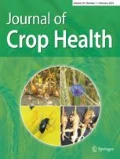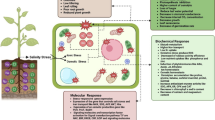Abstract
Although silicon (Si) has showed its potential role in mitigating abiotic stress-induced damages in many plant species its role in coordinated induction of antioxidant defense is yet to be elucidated. Therefore, we studied rapeseed (Brassica napus) seedlings applied with exogenous Si for changes occurring in antioxidant defense and glyoxalase systems. Seedlings (12-day-old) grown semi-hydroponically were exposed to Si (silicon dioxide, SiO2; 1 mM) solely and in combination with NaCl (100 and 200 mM) for 48 h. Salinity created oxidative damage by increasing H2O2 and malondialdehyde (MDA) contents resulting in disruption of antioxidant defense system and in arousing methylglyoxal (MG) toxicity by the down-regulation of glyoxalase enzyme activities. Exogenous Si treatment showed reduction of both H2O2 and MDA contents and up-regulation of antioxidant components including the activities of related enzymes (APX, MDHAR, DHAR, GR, GST, GPX and CAT) and the contents of AsA and GSH. Enhanced activities of glyoxalase I (Gly I) and glyoxalase II (Gly II) detoxified the toxic MG. Thus, this study clearly indicates that Si improved plant tolerance to salinity stress through enhancement of both antioxidant defense and glyoxalase systems that led to reduced oxidative damage and MG toxicity.
Zusammenfassung
Obwohl Silizium (Si) seine potenzielle Rolle bei der Abschwächung abiotischer stressinduzierter Schäden bei vielen Pflanzenarten gezeigt hat, ist seine Rolle bei der koordinierten Induktion der antioxidativen Abwehr noch zu klären. Daher untersuchten wir Rapskeimlinge (Brassica napus), die mit exogenem Si behandelt wurden, auf Veränderungen in der antioxidativen Abwehr und der Glyoxalase-Systeme. Keimlinge (12 Tage alt), die semi-hydroponisch gezüchtet wurden, wurden 48 h Si (Siliciumdioxid, SiO2; 1 mM) ausgesetzt – allein und in Kombination mit NaCl (100 und 200 mM). Die Salinität verursachte oxidative Schäden durch die Erhöhung des H2O2- und Malondialdehyd (MDA)-Gehalts, was zu einer Störung des antioxidativen Abwehrsystems und zur Stimulation der Methylglyoxal (MG)-Toxizität durch die Herunterregulierung der Glyoxalase-Enzymaktivitäten führte. Die exogene Si-Behandlung zeigte eine Reduktion der H2O2- und der MDA-Gehalte sowie eine Hochregulierung der antioxidativen Komponenten einschließlich der Aktivitäten verwandter Enzyme (APX, MDHAR, DHAR, GR, GST, GPX und CAT) und der AsA- und GSH-Gehalte. Verstärkte Aktivitäten von Glyoxalase I (Gly I) und Glyoxalase II (Gly II) entgifteten das toxische MG. Somit zeigt diese Studie deutlich, dass Si die Toleranz von Pflanzen gegenüber Salzstress durch die Steigerung der antioxidativen Abwehr und der Aktivität der Glyoxalase-Systeme verbesserte, was zu einer verringerten oxidativen Schädigung und MG-Toxizität führte.





Similar content being viewed by others
References
Ali S, Farooq MA, Yasmeen T, Hussain S, Arif MS, Abbas F, Bharwana SA, Zhang G (2013) The influence of silicon on barley growth, photosynthesis and ultra-structure under chromium stress. Ecotoxicol Environ Saf 89:66–72
Apel K, Hirt H (2004) Reactive oxygen species: metabolism, oxidative stress and signal transduction. Annu Rev Plant Biol 55:373–399
Assaha DVM, Liu L, Mekawy AMM, Ueda A, Nagaoka T, Saneoka H (2015) Effect of salt stress on Na accumulation, antioxidant enzyme activities and activity of cell wall peroxidase of huckleberry (Solanum ) and eggplant (Solanum melongena). Int J Agric Biol 17(6):1149–1156
Bela K, Horváth E, Gallé A, Szabados L, Tari I, Csiszár J (2015) Plant glutathione peroxidases: emerging role of the antioxidant enzymes in plant development and stress responses. J Plant Physiol 176:192–201
Booth J, Boyland E, Sims P (1961) An enzyme from rat liver catalyzing conjugation. Biochem J 79(3):516–524
Bradford M (1976) A rapid and sensitive method for the quantitation of microgram quantities of protein utilizing the principle of protein-dye binding. Anal Biochem 72(1–2):248–254
Cakmak I, Strbac D, Marschner H (1993) Activities of hydrogenperoxide scavenging enzymes in germinating wheat seeds. J Exp Bot 44(1):127–132
Coskun D, Britto DT, Huynh WQ, Kronzucker HJ (2016) The role of silicon in higher plants under salinity and drought stress. Front Plant Sci 7:1072
Debona D, Rodrigues FA, Rios JA, Nascimento KJT, Silva LC (2014) The effect of silicon on antioxidant metabolism of wheat leaves infected by Pyricularia oryzae. Plant Pathol 63:581–589
Dixon DP, Skipsey M, Edwards R (2010) Roles for glutathione transferases in plant secondary metabolism. Phytochemistry 71(4):338–350
El-Shabrawi H, Kumar B, Kaul T, Reddy MK, Singla-Pareek SL, Sopory SK (2010) Redox homeostasis, antioxidant defense, and methylglyoxal detoxification as markers for salt tolerance in Pokkali rice. Protoplasma 245(1–4):85–96
Elia AC, Galarini R, Taticchi MI, Dorr AJM, Mantilacci L (2003) Antioxidant responses and bioaccumulation in Ictalurus melas under mercury exposure. Ecotoxicol Environ Saf 55(2):162–167
Farooq MA, Saqib ZA, Akhtar J, Bakhat JF, Pasala RK, Dietz KJ (2016) Protective role of silicon (Si) against combined stress of salinity and boron (B) toxicity by improving antioxidant enzymes activity in rice. Silicon. https://doi.org/10.1007/s12633-015-9346-z
Foyer CH, Noctor G (2005) Oxidant and antioxidant signaling in plants: a re-evaluation of the concept of oxidative stress in a physiological context. Plant Cell Environ 28(8):1056–1071
Gill SS, Tuteja N (2010) Reactive oxygen species and antioxidant machinery in abiotic stress tolerance in crop plants. Plant Physiol Biochem 48(12):909–930
Hasanuzzaman M, Fujita M (2013) Exogenous sodium nitroprusside alleviates arsenic-induced oxidative stress in wheat (Triticum aestivum L.) seedlings by enhancing antioxidant defense and glyoxalase system. Ecotoxicology 22(3):584–596
Hasanuzzaman M, Hossain MA, Teixeira da Silva JA, Fujita M (2012) Plant response and tolerance to abiotic oxidative stress: antioxidant defense is a key factor. In: Venkateshwarulu B, Shanker AK, Shanker C, Mandapaka M (eds) Crop stress and its management: perspectives and strategies. Springer, Berlin, pp 261–316
Hasanuzzaman M, Nahar K, Fujita M (2013) Plant response to salt stress and role of exogenous protectants to mitigate salt-induced damages. In: Ahmad P, Azooz MM, Prasad MNV (eds) Ecophysiology and responses of plants under salt stress. Springer, New York, pp 25–87
Hasanuzzaman M, Alam MM, Rahman A, Hasanuzzaman M, Nahar K, Fujita M (2014a) Exogenous proline and glycine betaine mediated upregulation of antioxidant defense and glyoxalase systems provides better protection against salt-induced oxidative stress in two rice (Oryza sativa L.) varieties. Biomed Res Int. https://doi.org/10.1155/2014/757219
Hasanuzzaman M, Nahar K, Fujita M (2014b) Silicon and selenium: two vital trace elements that confer abiotic stress tolerance to plants. In: Ahmed P, Rasool S (eds) Emerging technologies and management of crop stress tolerance. Academic Press, New York, pp 377–422
Hasanuzzaman M, Nahar K, Hossain MS, Mahmud JA, Rahman A, Inafuku M, Oku H, Fujita M (2017a) Coordinated actions of glyoxalase and antioxidant defense systems in conferring abiotic stress tolerance in plants. Int J Mol Sci 18(1):200
Hasanuzzaman M, Nahar K, Anee TI, Fujita M (2017b) Glutathione in plants: biosynthesis and physiological role in environmental stress tolerance. Physiol Mol Biol Plants 23(2):249–268
Hasanuzzaman M, Nahar K, Anee TI, Fujita M (2017c) Exogenous silicon attenuates cadmium-induced oxidative stress in Brassica napus L. by modulating AsA-GSH pathway and glyoxalase system. Front Plant Sci 8:1061
Hashemi A, Abdolzadeh A, Sadeghipour HR (2010) Beneficial effects of silicon nutrition in alleviating salinity stress in hydroponically grown canola, Brassica napus L. plants. Soil Sci Plant Nutr 56(2):244–253
Heath RL, Packer L (1968) Photo peroxidation in isolated chloroplast: I. Kinetics and stoichiometry of fatty acid peroxidation. Arch Biochem Biophys 125(1):189–198
Hossain MA, Nakano Y, Asada K (1984) Monodehydroascorbate reductase in spinach chloroplasts and its participation in the regeneration of ascorbate for scavenging hydrogen peroxide. Plant Cell Physiol 25(3):385–395
Hossain MA, Hossain MZ, Fujita M (2009) Stress-induced changes of methylglyoxal level and glyoxalase I activity in pumpkin seedlings and cDNA cloning of glyoxalase I gene. Aust J Crop Sci 3(2):53–64
Huang C, He W, Guo J, Chang X, Su P, Zhang L (2005) Increased sensitivity to salt stress in ascorbate-deficient Arabidopsis mutant. J Exp Bot 56(422):3041–3049
Hussain M, Park HW, Farooq M, Jabran K, Lee DJ (2013) Morphological and physiological basis of salt resistance in different rice genotypes. Int J Agric Biol 15:113–118
Jiao-jing L, Shao-hang L, Pei-lei X, Xiu-juan W, Ji-gang B (2009) Effects of exogenous silicon on the activities of antioxidant enzymes and lipid peroxidation in chilling-stressed cucumber leaves. Agric Sci China 8:1075–1086
Kafi M, Nabati J, Zare Mehrjerdi M (2011) Effect of salinity and silicon application on oxidative damage of sorghum [Sorghum bicolor (L.) Moench]. Pak J Bot 43(5):2457–2462
Khoshgoftarmanesh AH, Khodarahmi S, Haghighi M (2014) Effect of silicon nutrition on lipid peroxidation and antioxidant response of cucumber plants exposed to salinity stress. Arch Agron Soil Sci 60(5):639–653
Kim Y‑H, Khan AL, Waqas M, Lee I‑J (2017) Silicon regulates antioxidant activities of crop plants under abiotic-induced oxidative stress: a review. Front Plant Sci 8:510
Mahmood S, Daur I, Al-Solaimani SG, Ahmad S, Madkour MH, Yasir M, Hirt H, Ali S, Ali Z (2016) Plant growth promoting rhizobacteria and silicon synergistically enhance salinity tolerance of mung bean. Front Plant Sci 7:876
Mahmud JA, Hasanuzzaman M, Nahar K, Rahman A, Hossain MS, Fujita M (2017) γ‑aminobutyric acid (GABA) confers chromium stress tolerance in Brassica juncea L. by modulating the antioxidant defense and glyoxalase systems. Ecotoxicology 26(5):675–690
Manivannan A, Soundararajan P, Muneer S, Ko CH, Jeong BR (2016) Silicon mitigates salinity stress by regulating the physiology, antioxidant enzyme activities, and protein expression in Capsicum annuum ‘Bugwang. Biomed Res Int. https://doi.org/10.1155/2016/3076357
Milne CJ, Laubscher CP, Ndakidemi PA, Marnewick JL, Rautenbach F (2012) Salinity induced changes in oxidative stress and antioxidant status as affected by applications of silicon in lettuce (Lactuca sativa). Int J Agric Biol 14(5):763–768
Nahar K, Hasanuzzaman M, Alam MM, Fujita M (2015) Roles of exogenous glutathione in antioxidant defense system and methylglyoxal detoxification during salt stress in mung bean. Biol Plant 59(4):745–756
Nahar K, Hasanuzzaman M, Rahman A, Alam MM, Mahmud JA, Suzuki T, Fujita M (2016) Polyamines confer salt tolerance in mung bean (Vigna radiata L.) by reducing sodium uptake, improving nutrient homeostasis, antioxidant defense, and methylglyoxal detoxification systems. Front Plant Sci 7:1104
Nakano Y, Asada K (1981) Hydrogen peroxide is scavenged by ascorbate-specific peroxidase in spinach chloroplasts. Plant Cell Physiol 22(5):867–880
Paradiso A, Berardino R, de Pinto M, di Toppi LS, Storelli FT, de Gara L (2008) Increase in ascorbate–glutathione metabolism as local and precocious systemic responses induced by cadmium in durum wheat plants. Plant Cell Physiol 49(3):362–374
Rahman A, Nahar K, Hasanuzzaman M, Fujita M (2016) Calcium supplementation improves Na+/K+ ratio, antioxidant defense and glyoxalase systems in salt-stressed rice seedlings. Front Plant Sci 7:609
Shahzad M, Qadir A, Masood S (2017) Silicon and alleviation of salt stress in crop genotypes differing in salt tolerance. In: Tripathi DK, Singh VP, Ahmad P, Chauhan DK, Prasad SM (eds) Silicon in plants: advances and future prospects. CRC, Boca Raton, pp 133–148
Shugaev AG, Lashtabega DA, Shugaeva NA, Vyskrebentseva EI (2011) Activities of antioxidant enzymes in mitochondria of growing and dormant sugar beet roots. Russ J Plant Physiol 58(3):387–393
Su Y, Guo J, Ling H, Chen S, Wang S, Xu L, Allan AC, Que Y (2014) Isolation of a novel peroxisomal catalase gene from sugarcane, which is responsive to biotic and abiotic stresses. PLoS ONE. https://doi.org/10.1371/journal.pone.0084426
Torabi F, Majd A, Enteshari S (2015) The effect of silicon on alleviation of salt stress in borage (Borago officinalis L.). Soil Sci Plant Nutr 61(5):788–798
Yadav SK, Singla-Pareek SL, Ray M, Reddy MK, Sopory SK (2005) Methylglyoxal levels in plants under salinity stress are dependent on glyoxalase I and glutathione. Biochem Biophys Res Commun 337(1):61–67
Yadav SK, Singla-Pareek SL, Ray M, Reddy MK, Sopory SK (2008) An overview on the role of methylglyoxal and glyoxalases in plants. Drug Metabol Drug Interact 23(1–2):51–68
Yu CW, Murphy TM, Lin CH (2003) Hydrogen peroxide-induces chilling tolerance in mung beans mediated through ABA-independent glutathione accumulation. Funct Plant Biol 30:955–963
Acknowledgements
We acknowledge Ms. Khursheda Parvin, Assistant Professor, Department of Horticulture, Faculty of Agriculture, Sher-e-Bangla Agricultural University, Dhaka, Bangladesh for the critical reading and editing of the manuscript.
Author information
Authors and Affiliations
Corresponding author
Ethics declarations
Conflict of interest
M. Hasanuzzaman, K. Nahar, M.M. Rohman, T.I. Anee, Y. Huang and M. Fujita declare that they have no competing interests.
Rights and permissions
About this article
Cite this article
Hasanuzzaman, M., Nahar, K., Rohman, M.M. et al. Exogenous Silicon Protects Brassica napus Plants from Salinity-Induced Oxidative Stress Through the Modulation of AsA-GSH Pathway, Thiol-Dependent Antioxidant Enzymes and Glyoxalase Systems. Gesunde Pflanzen 70, 185–194 (2018). https://doi.org/10.1007/s10343-018-0430-3
Received:
Accepted:
Published:
Issue Date:
DOI: https://doi.org/10.1007/s10343-018-0430-3




